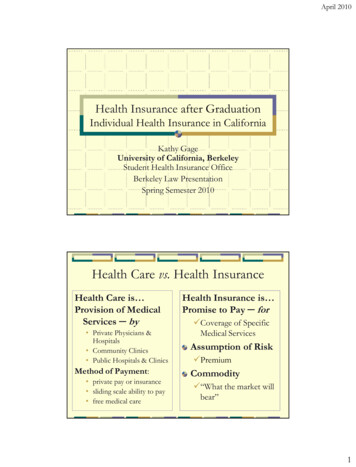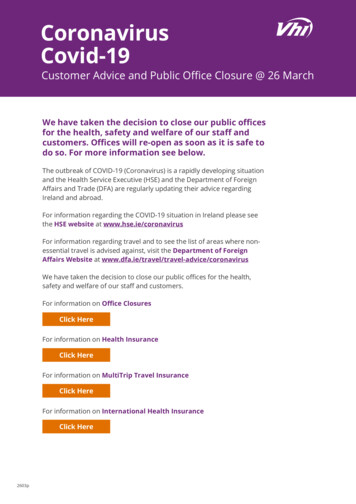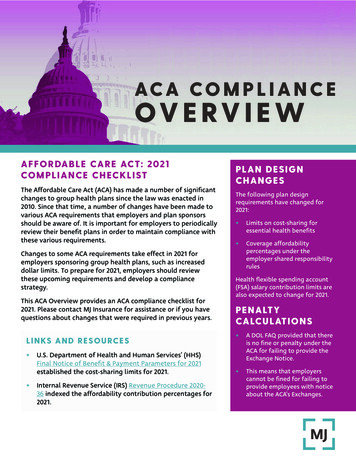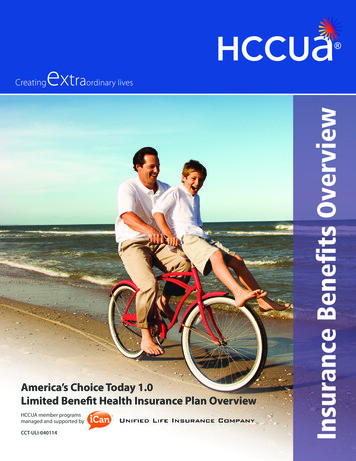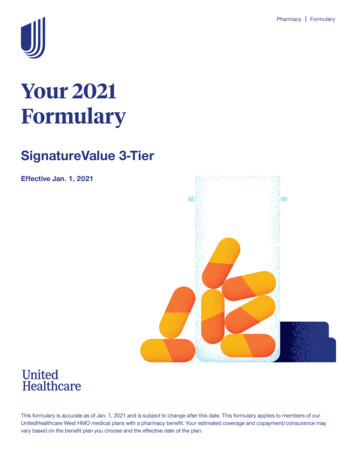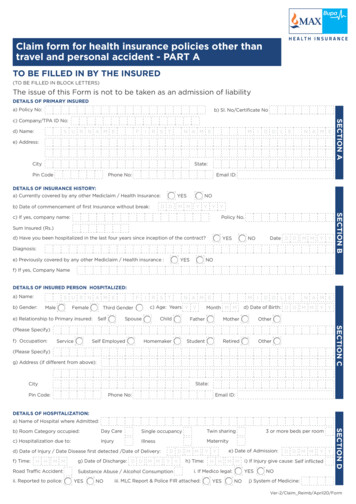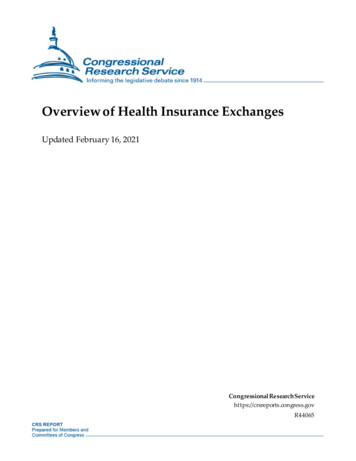
Transcription
Overview of Health Insurance ExchangesUpdated February 16, 2021Congressional Research Servicehttps://crsreports.congress.govR44065
SUMMARYOverview of Health Insurance ExchangesR44065February 16, 2021The Patient Protection and Affordable Care Act (ACA; P.L. 111-148, as amended)required health insurance exchanges to be established in every state. Exchanges areVanessa C. ForsbergAnalyst in Health Carevirtual marketplaces in which consumers and small business owners and employees canFinancingshop for and purchase private health insurance coverage and, where applicable, beconnected to public health insurance programs (e.g., Medicaid). In general, states musthave two types of exchanges: an individual exchange and a small business healthoptions program (SHOP) exchange. Exchanges may be established either by the stateitself as a state-based exchange (SBE) or by the Secretary of Health and Human Services (HHS) as a federallyfacilitated exchange (FFE). Some states have SBE-FPs: they have SBEs but use the federal informationtechnology platform (FP), including the federal exchange website www.HealthCare.gov.A primary function of the exchanges is to facilitate enrollment. This generally includes operating a web portal thatallows for the comparison and purchase of coverage; making determinations of eligibility for coverage andfinancial assistance; and offering different forms of enrollment assistance, including Navigators and a call center.Exchanges also are responsible for several administrative functions, including certifying the plans that will beoffered in their marketplaces.The ACA generally requires that the private health insurance plans offered through an exchange are qualifiedhealth plans (QHPs). To be a certified as a QHP, a plan must be offered by a state-licensed health insurance issuerand must meet specified requirements, including covering the essential health benefits (EHB). QHPs sold in theindividual and SHOP exchanges must comply with the same state and federal requirements that apply to QHPsand other health plans offered outside of the exchanges in the individual and small-group markets, respectively.Additional requirements apply only to QHPs sold in the exchanges. Exchanges also may offer variations of QHPs,such as child-only or catastrophic plans, and non-QHP dental-only plans.Individuals and small businesses must meet certain eligibility criteria to purchase coverage through the individualand SHOP exchanges, respectively. There is an annual open enrollment period during which any eligibleconsumer may purchase coverage via the individual exchanges; otherwise, consumers may purchase coverageonly if they qualify for a special enrollment period. In general, small businesses may enroll at any time during theyear. There are plans available in all individual exchanges, and, as of February 2020, about 10.7 million peopleobtained health insurance through the individual exchanges. (2021 open enrollment data for all states are expectedin spring 2021.) Nationwide SHOP exchange enrollment estimates are not regularly released; in addition, there areno SHOP exchange plans available in more than half of states in 2021.Plans sold through the exchanges, like private health insurance plans sold off the exchanges, have premiums andout-of-pocket (OOP) costs. Consumers who obtain coverage through the individual exchange may be eligible forfederal financial assistance with premiums and OOP costs in the form of premium tax credits and cost-sharingreductions. Small businesses that use the SHOP exchange may be eligible for small business health insurance taxcredits that assist with the cost of providing health insurance coverage to employees.The federal government spent an estimated 1.8 billion on the operation of exchanges in FY2020, and it projected 1.2 billion in spending for FY2021. Much of the federal spending on the exchanges is funded by user fees paidby the insurers who participate in FFE and SBE-FP exchanges. States with SBEs finance their own exchangeadministration; states with SBE-FPs also finance certain costs (e.g., consumer outreach and assistance programs,including Navigator programs).This report provides an overview of the various components of the health insurance exchanges. It begins withsummary information about the types of exchanges and their administration. Sections on the individual and SHOPexchanges discuss eligibility and enrollment, plan costs and financial assistance available to eligible consumersand small businesses, insurer participation, and other topics. The final sections address types of enrollmentassistance available to exchange consumers and federal funding for the exchanges.Congressional Research Service
Overview of Health Insurance ExchangesContentsIntroduction . 1Overview . 2Types and Administration of Exchanges . 2Individual and SHOP Exchanges . 2State-Based and Federally Facilitated Exchanges . 3Exchange Administration. 5Qualified Health Plans. 6Individual Exchanges . 7Eligibility and Enrollment . 7Interaction with Medicaid, CHIP, and Medicare . 8Open and Special Enrollment Periods . 8Special Enrollment Periods and COVID-19. 10Enrollment Estimates . 11Premiums and Cost Sharing . 12Premium Tax Credits and Cost-Sharing Reductions . 14Insurer Participation. 17SHOP Exchanges . 19Eligibility and Enrollment . 19Enrollment Periods . 20Online Enrollment versus Direct Enrollment. 20Enrollment Estimates . 22Congressional Member and Staff Enrollment via the D.C. SHOP Exchange . 22Premiums and Cost Sharing . 22Small Business Health Care Tax Credit . 23Insurer Participation. 24Exchange Enrollment Assistance . 24Navigators and Other Exchange-Based Enrollment Assistance. 24Brokers, Agents, and Other Third-Party Assistance Entities . 26Exchange Spending and Funding. 26Initial Grants for Exchange Planning and Establishment . 26Ongoing Federal Spending on Exchange Operation. 27Funding Sources for Federal Exchange Spending . 27User Fees Collected from Participating Insurers . 27Other Federal Funding Sources. 29State Financing of the Exchanges . 29FiguresFigure 1. Individual and SHOP Exchange Types by State, Plan Year 2021. 5Figure 2. Plan Year 2021 Insurer Participation in the Individual Exchanges, by County. 17Figure 3. Federal User Fee for Insurers Participating in Specified Types of IndividualExchanges, by Plan Year. 28Congressional Research Service
Overview of Health Insurance ExchangesFigure C-1. Centers for Medicare & Medicaid Services “Health Insurance ExchangesTransparency Table,” FY2021 . 38TablesTable 1. Open Enrollment Periods for Individual Exchanges on the Federal Platform, byPlan Year . 9Table 2. Nationwide Individual Exchange Enrollment Estimates, by Plan Year . 12Table 3. Annual Out-of-Pocket Limits, by Plan Year . 14Table 4. Data on Premiums, Advance Premium Tax Credits, and Cost-Sharing ReductionsNationwide, by Plan Year . 16Table A-1. Exchange Types and Key Details by State, Plan Year 2021 . 31Table B-1. Types of Plans Offered Through the Exchanges . 35Table C-1. CMS Federal Exchange Funding Sources for Specified Fiscal Years . 39Table D-1. HHS “Notice of Benefits and Payment Parameters,” Final Rule by Year. 40AppendixesAppendix A. Exchange Information by State . 30Appendix B. Types of Plans Offered Through the Exchanges . 35Appendix C. Exchange Spending and Funding Details from CMS Budget Justifications . 37Appendix D. Additional Resources . 40ContactsAuthor Information . 42Congressional Research Service
Overview of Health Insurance ExchangesIntroductionThe Patient Protection and Affordable Care Act (ACA; P.L. 111-148, as amended) required healthinsurance exchanges (also known as marketplaces) to be established in every state. The ACAexchanges are virtual marketplaces in which consumers and small businesses can shop for andpurchase private health insurance coverage and, where applicable, be connected to public healthinsurance programs (e.g., Medicaid). 1 Certain consumers and small employers are eligible forfinancial assistance for private health insurance purchased (only) through the exchanges.Exchanges are intended to simplify the experience of obtaining health insurance. They are notintended to supplant the private market outside of the exchanges but rather to provide anadditional source of private health insurance coverage options.The exchanges may be administered by state governments and/or the federal government.Regardless, the major functions of the exchanges are (1) to facilitate consumers’ and smallbusinesses’ purchase of coverage (by operating a web portal, making determinations of eligibilityfor coverage and any financial assistance, and offering different forms of enrollment assistance)and (2) to certify, recertify, and otherwise monitor the plans that are offered in thosemarketplaces.Although a relatively small proportion of people in the U.S. obtain their coverage through theexchanges, 2 the administration and functioning of these marketplaces are ongoing topics ofinterest to congressional audiences and other stakeholders. An understanding of the exchangescan provide context for current health policy discussions and proposals related to health carecoverage and costs, the roles of the public and private sectors in the provision of health coverage,and more.This report provides an overview of key aspects of the health insurance exchanges. It begins withsummary information about types and administration of exchanges and the plans sold in them.Sections on the individual and small business exchanges discuss eligibility and enrollment, plancosts and financial assistance available to eligible consumers and small businesses, insurerparticipation, and other topics. The final sections describe types of enrollment assistance availableto exchange consumers and provide information on federal funding for the exchanges.Appendixes offer further details, including exchange types by state.1In this report, the terms consumers and individuals generally are used interchangeably, as are small businesses andsmall employers.2For example, as of February 2020, about 10.7 million people obtained health insurance through the individualexchanges. T his figure is approximately 3% of the current U.S. population of 330 million people. See Table 2regarding exchange enrollment estimates and sources. For current U.S. population, see U.S. Census, “U.S. and WorldPopulation Clock,” accessed September 2, 2020, at https://www.census.gov/popclock/.Congressional Research Service1
Overview of Health Insurance ExchangesOverviewTypes and Administration of ExchangesIndividual and SHOP ExchangesThe ACA required health insurance exchanges to be established in all states and the District ofColumbia. 3 In general, the health insurance exchanges began operating in October 2013 to allowconsumers to shop for health insurance plans that began as soon as January 1, 2014.There are two types of exchanges—individual exchanges and small business health optionsprogram (SHOP) exchanges. 4 These exchanges are part of the individual (also called non-group)and small-group segments of the private health insurance market, respectively. 5 In an individualexchange, eligible consumers can compare and purchase non-group insurance for themselves andtheir families and can apply for premium tax credits (PTCs) and cost-sharing subsidies (see“Premium Tax Credits and Cost-Sharing Reductions,” below). In a SHOP exchange, smallbusinesses can compare and purchase small-group insurance and can apply for small businesshealth insurance tax credits (“Small Business Health Care Tax Credit,” below); in addition,employees of small businesses can enroll in plans offered by their employers on a SHOPexchange.Each exchange covers a whole state. 6 Within a given exchange, private insurers may offer plansthat cover the whole state or only certain areas within the state (e.g., one or more counties). Planssold within a given exchange may cover services offered by providers located in more than onestate.In general, consumers and small businesses may obtain coverage within their state’s individual orSHOP exchange, respectively, or they may shop in the individual or small-group health insurancemarkets outside of the exchanges, which existed prior to the ACA and continue to exist. 7 Outsideof the ACA exchanges, consumers can purchase coverage through agents or brokers, or they canpurchase it directly from insurers. In addition, there were and still are privately operated websitesthat allow the comparison and purchase of coverage sold by different insurers, broadly similar inconcept to the ACA exchanges. 83T he Patient Protection and Affordable Care Act (ACA; P.L. 111-148, as amended) also gave the territories the optionof establishing exchanges, but none elected to do so, by th e statutory deadline of October 1, 2013. See 42 U.S.C.§18043.4 T he term individual exchange is used for purposes of this report. It is not defined in exchange-related statute orregulations.5T he private health insurance market includes both the group market (largely made up of employer-sponsoredinsurance) and the individual market (which includes plans directly purchased from an insurer). T he group market isdivided into small- and large-group market segments; a small group is typically defined as a group of up to 50individuals (e.g., employees), and a large group is typically defined as one with 51 or more individuals.6T here is an option for states to coordinate in administering regional exchanges or for a single state to establishsubsidiary exchanges that serve geographically distinct areas (see 45 C.F.R. §155.410) , but none have done so.7 However, plans are not available in all small business health options program (SHOP) exchanges in 2021.8An example of a privately owned website that allows for comparison and purchase of coverage from different insurersis ehealthinsurance.com. Note that some types of coverage sold outside of the federal and state exchanges, potentiallyincluding some types of coverage available on private sites like t his one, are not subject to some or all federal healthinsurance requirements. For more information, see CRS Report R46003, Applicability of Federal Requirements toSelected Health Coverage Arrangements.Congressional Research Service2
Overview of Health Insurance ExchangesState-Based and Federally Facilitated ExchangesA state can choose to establish its own state-based exchange (SBE). If a state opts not toadminister its own exchange, or if the Department of Health and Human Services (HHS)determines the state is not in a position to do so, then HHS is required to establish and administerthe exchange in the state as a federally facilitated exchange (FFE).There is one variation on the SBE approach: a state may have a state-based exchange using afederal platform (SBE-FP), which means the state oversees the exchange but uses the federallyfacilitated information technology (IT) platform, or federal platform (FP) (i.e., HealthCare.gov).There is also a variation on the FFE approach: a state may have a state partnership FFE, whichallows the state to manage certain aspects of its exchange while HHS manages the remainingaspects and has authority over the exchange. In early guidance on this option, HHS indicated astate could elect to perform some plan management and/or certain consumer assistance functions,and HHS would perform other functions, including facilitating enrollment through the federalHealthCare.gov platform and funding Navigator entities in the state. 9 In federal and privateresources that track exchange data, this variation may not be reported on separately but rathermay be included in overall counts of FFEs, which is the model this report generally follows. 10In rulemaking finalized January 19, 2021 (the 2022 Notice of Benefit and Payment Parameters, or“Payment Notice”11 ), HHS and the Department of the Treasury established new “directenrollment” variations of the exchange types: FFE-DE, SBE-DE, and SBE-FP-DE. 12 Stateselecting these options would “adopt a private sector-based enrollment approach as an alternativeto the consumer-facing enrollment website operated by the Exchange (for example,HealthCare.gov for the FFEs).” In other words, consumers would enroll in exchange plans viaprivate agents or brokers, rather than on an exchange website like HealthCare.gov. The exchangewould still have to “make available a website listing basic [qualified health plan] Q
Feb 16, 2021 · have two types of exchanges: an individual exchange and a small business health options program (SHOP) exchange. Exchanges may be established either by the state itself as a state-based exchange (SBE) or by the Secretary of Health and Human Services (HHS) as


